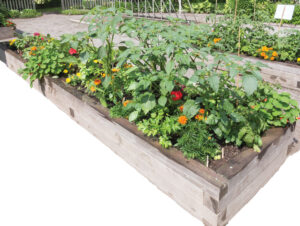
In terms of garden trends, recycling and reusing items in the garden continues to be as popular as ever. A variety of items you likely already have at home may be able to save you money this year, as well as improve the sustainability of your gardening. Get creative this spring and make a difference to the environment.
Seed starting
Jump-start your garden by starting seeds indoors in a bright southern- or western-facing window or under supplemental lighting. Many containers you may already have on hand (plastic milk jugs, egg cartons, toilet paper rolls, newspaper, milk cartons, and other reusable and even biodegradable containers) can easily be filled with soilless media for starting seeds. Any container that is clean and safe for growing food can be used.
Weed control
With weed control commonly being a time-consuming maintenance task during the growing season, consider recycling your newspapers and cardboard boxes as biodegradable weed barriers. Simply place a few layers of newspaper or a section of cardboard over an area of bare soil and cover with your favorite mulch material such as bark mulch, grass clippings or leaves.
The newspaper or cardboard will naturally degrade over time and you can simply add a new layer or more mulch as needed to keep the soil covered. Cardboard and newspaper is the only means of weed barrier I use under my bark mulch now and it works great.
Alternative raised beds
Raised garden beds are a great solution when your garden soil is not ideal, or you’d like to create a growing area that is easier to access. Many raised beds are made of purchased wood, but you may already have suitable construction materials, like a wood pallet, on hand. Simply staple landscape fabric to the sides and open bottom of the pallet and fill with soil. The result is an excellent shallow bed for growing lettuce with very minimal weeding needed.
If you are growing food in a raised bed, always consider the safety of the construction material. Some pallets are chemically treated and thus inappropriate for growing food. Railroad ties are coated with creosote, which is not recommended for growing food. Other candidates for raised beds might be bricks left over from other garden projects and cinder blocks, whose holes you can fill with soil and plant into. Beds can also be lined with a layer of plastic to prevent the soil from contacting the material, if the safety of the material is in question.
Garden art
Get the kids involved and start crafting recycled materials into gorgeous works of art for the garden. Glue tea cups and plates together on a pole to make small bird baths for the garden. Glue small plates filled with bird seed onto an old chandelier and hang from your tree to feed the birds as well. The possibilities are endless.
This spring, take a look at your garden with a new eye. You may be able to reuse and recycle materials you have on hand to save yourself money and reduce your gardening footprint.
Candice Hart is a Horticulture Educator with University of Illinois Extension serving DeWitt, Macon and Piatt counties. She is also a Certified Floral Designer, Illinois Certified Professional Florist and is an award winning floral designer.









